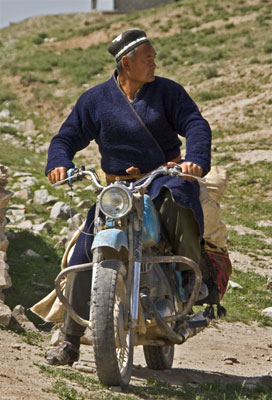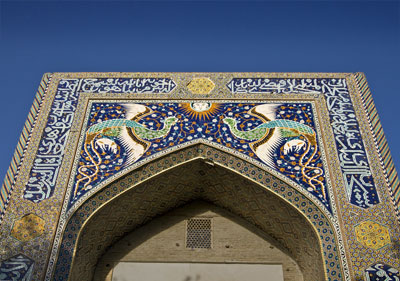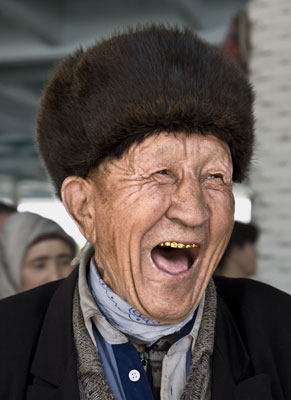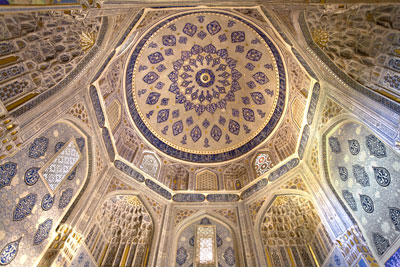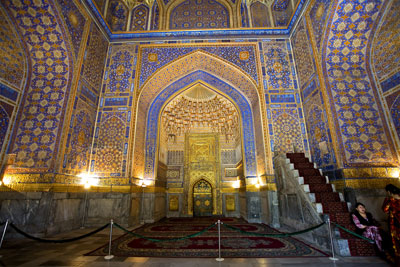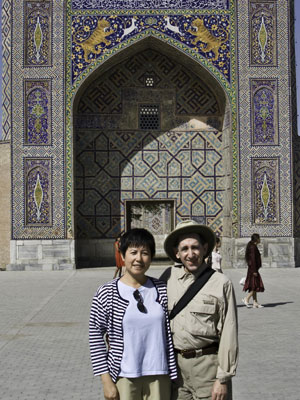Madrassahs, monuments and mosques — a private tour of Uzbekistan
by Steven Emmet, Solana Beach, Ca.
“Uzbekistan?” “Where is it?” “Why are you going there?” “Is it safe?” These were the questions most often asked regarding my planned April-May ’08 trip.
Where is easily answered by a quick trip to Wikipedia. Bordering Kazakhstan and the Aral Sea to the north and northwest, Turkmenistan to the southwest, Tajikistan to the southeast and Kyrgyzstan to the northeast, Uzbekistan is not only one of the larger Central Asian states but the only Central Asian state to border all the other four.
“Why?” is a more difficult question, but the best answer I can give is I had fond memories of the lovely, old Silk Road madrassahs (schools) and mosques that I had seen in 1974, when Uzbekistan was still part of the USSR, and I wanted to share these memories with my wife, Yuki. I also wanted to rephotograph these places — with better cameras and, hopefully, better skills.
With our usual luck, a friend of a friend introduced us to a young lady, Zulya Rajabova, who had worked at Bukharatravel, a major travel company in Bukhara. She used her contacts to quickly set up an excellent and inexpensive tour.
Zulya now has her own travel agency in the US (Chester, NJ; 908/719-7676, www.silkroadtreasuretours.com), and I highly recommend it for any of you who might, after reading this report, develop a hankering to visit this fascinating country.
Finally, is it safe? I wasn’t sure before we left, but, for various reasons, I felt safer in Uzbekistan than almost any other place in the world, almost boringly safe. There were no pickpockets, no screams and no sirens in the night. No cliques of seedy men with beady eyes hanging around buses or train stations. No groups of children pushing and shoving, then stealing wallets. Safe.
Getting there
Airfares, in general, are no longer inexpensive, so we wanted to use frequent-flyer mileage as much as possible. Plus, given the distance, we wanted to travel business class. After about a zillion calls to the various mileage clubs to which we belong, we finally got business-class tickets to Chicago on American Airlines and from Chicago to Istanbul on Turkish Airlines.
The last leg of the flight, from Istanbul to Tashkent on Turkish Airlines, would have to be in economy class, but, as it was only four hours, I thought it would be do-able. We paid $750 each, round trip, for this flight.
By the way, if you fly business-class on Turkish Airlines, you get a special pass that lets you go through the VIP Customs area in Istanbul, which took us but five minutes to clear.
Before continuing on to Uzbekistan, we spent a day and night in Istanbul — a wonderful city for touring, photography and shopping — staying at Hotel Uyan (www.uyanhotel.com). At about $150 per night, the hotel was inexpensive and had nice rooms, in addition to being conveniently located quite near both Hagia Sophia and the Blue Mosque.
Tashkent
The following morning we boarded the jam-packed 4 a.m. flight to Tashkent. The food was terrible, and I had forgotten how old planes, like this one, weren’t insulated — the bulkhead next to my seat was absolutely freezing!
The flight was only four hours, but it seemed about twice as long. We finally arrived, on time, but soon discovered that the old-style Soviet approach is apparently still alive and well at Passport Control. The luggage check (your luggage is x-rayed when you enter the country) wasn’t much better.
At each site, eight or so folks elbowed each other as the line narrowed to seven and then six people until, finally, one person stood in front of the bored and slow-moving government official. Of course, various officials and larger folks cut in ahead of the rest of us. From touchdown to finally leaving the airport, it took about 1½ hours.
Our guide, the good Golibjon, and our driver, Mr. Hikmat (both were to become excellent friends), were there to meet us and soon we were ensconced in the Radisson Hotel, which had been nicely renovated and had a huge breakfast included. It also advertised a free, fast Internet connection, which was free but was as fast as a 38k modem from about 15 years ago.
The local guide, Dilya, showed us around the city, but, in keeping with what I remembered, there wasn’t much to see in Tashkent, as all was rebuilt after a 1966 earthquake. A few rebuilt mosques, a nice food-and-clothing market, the usual government buildings and a very nice train museum were all that was of interest to us.
Our tour included an opera/ballet house, where we invested $3 each for the best seats in the house for “Tumaris,” a ballet being shown that evening. We caught just the first act, which was enough, as the music was a cross between Stravinsky and Soviet marching music and the dancers were not yet a threat to those of the Kirov.
Dinner was at Café Buxoro, where four of us feasted on homemade bread, soup, fish and salad for a total of about $20.
Samarkand
The next morning, after a fairly easy 4-hour drive, we arrived in lovely downtown Samarkand. We checked into the President Hotel, appropriately labeled a 4-star. I quickly learned that while they also had Internet service, I could log on only in their business office; I couldn’t use my own computer.
There were no nonsmoking rooms in the hotel, but ours wasn’t too bad. We dropped off our bags and went for lunch.
Labi G’or had both foreign and Uzbeki customers but, as it was about 2 p.m., was all out of food except for salads, soup and local bread, which were filling and cost about $9 for four people.
We were dropped off at the hotel and soon walked back to the Registan area, the main tourist site in Samarkand, about a 20-minute walk. We took pictures of the various madrassahs and were a bit surprised when a local policeman, after ascertaining that we were a group of only two, opened a locked door and invited us to climb to the top of one of the minarets! Of course, a small gift was expected, and we settled for 4,000 so‘m, about $3.50, each. (At the current exchange rate, 4,000 so‘m = $2.88 — Editor.)
Incidentally, the largest denomination in Uzbekistan is a 1,000-so‘m note, which was worth about 75¢. If you have to buy something very expensive, bring either dollars or a small suitcase filled with so‘m. When I asked why larger bills aren’t printed, I was told the government didn’t have the extra cash to do so.
City sights
The next morning our guide, Golib, a brilliant young man who speaks six languages fluently, picked us up at 9:00 and, with Shakhida as our local guide, we went back to officially visit the Registan.
We also visited the Gur-Emir mausoleum, the Bibi Khanum Mosque, the Shah-i-Zinda necropolis and, of course, Ulug Bek’s observatory, where we saw the rails used to move some of his stargazing equipment into position. Between visits to these very impressive though rejuvenated buildings, we shopped at a fruit market and a market for clothes.
Lunch was at the Tumor Restaurant (as always, about $5 each), and we had some coffee at the Blues Café, where, apparently, they play live blues music on the weekends.
We turned down dinner at the “Uzbek Cultural Dinner” site and instead ate at the Oasis Restaurant. We weren’t exactly able to see what we were eating, as that area of the city was blacked out for most of our dinner, but the chicken was tasty and the salads okay if not inspired.
Part of the next day was spent at the Samarkand Bukhara Silk Carpets Workshop (www.silkcarpets.net), where we met Abullahad Badghisi, the owner and a physician. His carpets were inexpensive and quite nice, and they even can be woven to order.
On our final morning in Samarkand, we visited the city’s main bazaar for some excellent raisins, walnuts and fresh fruits, including a kuk sultan (a local cherry plum), which was small, green and somewhat bitter but very refreshing.
I was surprised at how tasty and sweet the tiny raisins were. When I inquired, I was told they were dried slowly in the shade, maintaining the excellent flavor. The walnuts, already out of their shells, were also superb.
Shakhrisabz
Next we set out for Shakhrisabz, about a 3-hour drive from Samarkand. Shakhrisabz is famous for its huge 8-story gates, all that is left of the Ak-Saray Palace of Timur the Lame (Tamerlane), who was born there in 1336. They really were stunning, and you can let your imagination roam and build, in your mind’s eyes, a palace worthy of these gates. It must have been extremely impressive.
We stayed at the Oriental Star Hotel, which was barely three stars, with marginal facilities and without much hot water. I discussed this with Golib and we decided that visiting Shakhrisabz on a day trip from Samarkand is probably a better choice.
Bukhara
After some early-morning pictures of the Great Gates (lighting is everything), we happily checked out of the Oriental Star. Before we departed the city, we stopped at the Dor-ut-Tilovat (House of Meditation) mosque complex, then continued to the famous Silk Road city of Bukhara. The farther west we drove, the drier and flatter it got.
It’s a reach to assign the Bukhara Hotel four stars, as it was clearly a leftover of some Soviet-style central planning group, with air-conditioning that was controlled centrally (‘We will tell you how cold you should be!’). The fit and finish were abysmal, and the lobby was filled with cigarette smoke.
We ate dinner at Golib’s family house, out in the suburbs. Golib’s dad, who had been an English teacher and then worked in the central government, built houses for his older son and three daughters (Golib, being the younger son, still lives with his parents, according to tradition), so they all live nearby.
I found this tradition of having three generations within walking distance very heartwarming, but I wonder if it will survive another generation. Many Uzbekis now work in Russia and Europe to earn salaries not obtainable in Uzbekistan, coming home only intermittently.
Local attractions
There are lots of interesting mosques, madrassahs and monuments in Bukhara, many dating to the 14th century. Genghis Khan, Alexander the Great and others, most importantly the Persians, have invaded Bukhara, each leaving a mark, genetically and architecturally. Rather than list all of the city’s famous sites, I’ll refer readers to Wikipedia and www.bukhara.net/magictoday/monuments.htm for a brief history and photos of each.
Yuki and Golib climbed to the top of Bukhara’s famous minaret, located adjacent to the square where British prisoners Col. Charles Stoddart and Capt. Arthur Conolly, accused of spying for the British, were beheaded — a welcome death after the many years of imprisonment they had suffered. We later visited the Zindan, where they had been held, an 18-foot-deep pit that had been filled with vermin.
The next day, after purchasing a nice rug and some cumin, which Yuki said was the best she’s tasted, we went to the hamams, or steam baths, in the heart of the city. For $20, our guide and I relaxed in the warm rooms and had a brisk massage and shampoo.
The lady’s hamam, naturally, was well off the beaten path, hidden down a side street. Yuki said that, while the hamam was nice, the massage was not particularly expert.
The baths are open to locals until 4 p.m., and the entire place, which is fairly small, can be rented by others from 4 to 6 p.m. without restrictions for males, females or mixed groups.
Khiva
After a final morning in Bukhara, we set out for Urgench (Orgench). It was a long trip through the desert, about six hours on fair to poor roads.
We finally arrived at the Khorezm Palace which, compared to all the other hotels, was indeed palatial. We had a huge room with a large bathtub, but the hotel had no elevator, so if your bags are heavy or you are stair challenged you’ll need to stay on the first floor.
We picked up our local guide, a nice lady called Delia, and we drove about 30 minutes to Khiva. She quickly learned that we did not have a great interest in historical facts, which she had at her fingertips, so she helped us find good places for photos.
Coming to an end
I have perhaps unfairly glossed over the lovely buildings that we saw in Samarkand, Bukhara and Khiva.
Most are 350 or more years old, and both the mosques and the madrassahs are covered with absolutely fabulous blue tiles and paintings. Indeed, to take pictures of them was one of the main reasons we went.
Even though most buildings have been “repaired,” to the dismay of some, I think they did a wonderful job. I could imagine riding for long weeks or even months on the back of a camel and suddenly seeing these huge, magnificent edifices appear out of seemingly nowhere. It must have been a moving and religious experience.
A brief flight brought us back to Tashkent, where we rested for a few hours before returning to Istanbul.
As nontravelers are not allowed into the Tashkent airport, we had to find our own way to the check-in counter, finally boarding our early-morning, packed-like-sardines Turkish Airlines flight to Istanbul.
We once again used our VIP passes to quickly and easily enter Turkey and spent the next few days again enjoying the pleasures of Istanbul.
Recommendations
Instead of following the path we did, I’d suggest that those interested in visiting Uzbekistan fly into Tashkent (there is really no other option) and then fly directly west to Urgench. Spend one day in Khiva, a mere 30 minutes or so away, then fly over the desert to Bukhara.
At that point, I’d suggest hiring a private driver (Mr. Hikmat is highly recommended) to see Bukhara and Samarkand, including a stop at Shakhrisabz either on the way to Samarkand or as a separate day trip from Samarkand.
In all these cities, avoid the larger hotels (except the Khorezm Palace in Urgench, which is fine) and stay at small hotels closer to the monuments so you can visit them on your own as well as with your guide. The drive from Samarkand back to Tashkent is not bad, and the Radisson there is acceptable.
To help plan your trip, talk to Zulya at Silk Road Treasure Tours, who can give you up-to-date advice. Uzbekistan is safe, inexpensive and a lot of fun to visit.
We got a special “friends” rate of about $5,500 for the two of us for the 12 days, which included hotels, breakfasts and dinners (at the restaurants of our choice), driver and guide, as well as the in-country flight.
I cannot recommend Golib highly enough. He’s funny, knowledgeable, speaks university-level English and has become a good friend.


